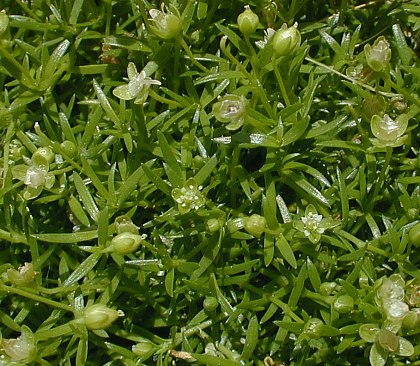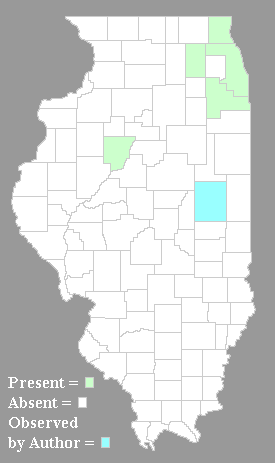Description: This herbaceous perennial plant is 2-6" long. It often forms a rosette of leaves, from which one or more stems develop. These stems are bright green, glabrous, and tend to sprawl across other stems or the ground. Pairs of opposite leaves occur at intervals along the stems. Each pair of leaves merge together and wrap around the stem, which is slightly swollen where each pair of leaves occurs. Each leaf is about ½" long and bright green like the stems. It is linear, glabrous, and smooth along the margins.

The stems often
terminate in either individual flowers or small cymes of flowers. Each
flower is up to ¼" across when fully open, consisting of 4 green
sepals, 0-4 white petals, 4 stamens with white anthers, 4 white styles,
and a green ovary that contains the developing seeds. The sepals are
oblong-ovate and persistent. The petals are usually shorter and more
narrow than the sepals; they are often missing or poorly developed in
individual flowers. The blooming period occurs from mid- to late spring
and lasts about 1 month for a colony of plants. There is no noticeable
floral scent. The ovary of each flower develops into an ovoid seed
capsule that is white and membranous; there are 4 blunt teeth along its
upper rim. Each capsule contains several dark tiny seeds that can be
blown about by the wind. The surface of each seed is minutely pebbly.
The root system consists of a slender taproot that is shallow and
divides frequently into secondary roots. This plant spreads by
reseeding itself and it often forms small colonies of plants with a
mossy appearance.
Cultivation:
The preference is light shade to full sun and rather moist conditions
during the spring. Rocky or sandy soil is preferred as this reduces
competition from other plants. Most vegetative growth occurs during the
spring while the weather is moist and cool. This plant can survive a
limited amount of trampling, but flourishes better without it.
Range & Habitat:
Procumbent Pearlwort occurs occasionally in NE Illinois; it is rare or
absent elsewhere. This species has a circumboreal distribution,
occurring in both North America and Eurasia as a native plant. In North
America, Illinois is located along the southern boundary of the range
for this species. Habitats include sandy ridges in open woodlands,
rocky open ground, and cracks between bricks and patio blocks. It can
be found in either natural or disturbed areas where there is scant
vegetation on the ground.
Faunal Associations:
Little information is available about floral-faunal relationships. Most
likely small bees and flower flies visit the flowers for nectar or
pollen. The flowers can develop fertile seeds without insect
pollinators.
Photographic Location:
Mat-like colonies of plants were growing in the cracks between patio
blocks on the campus of the University of Illinois in Urbana, Illinois.
Comments:
During the spring, the foliage of Procumbent Pearlwort has a refreshing
appearance. While the flowers are often produced abundantly and are
rather large considering the small size of the plant, they are usually
not very showy because of the small size or absence of the petals. Some
authorities assert that the flowers have 4 petals that are about as
long as the sepals, but this is often untrue. Frequently, the petals
are deformed or missing in individual flowers, and they are usually
much shorter than the sepals. Until recently, all Pearlworts in
Illinois were lumped together as Sagina decumbens
(Decumbent Pearlwort), but it is now recognized that there are at least
4 Sagina spp. (Pearlworts) in Illinois. These
species can be divided into 2 groups: those with 5 sepals and those
with 4 sepals. In Illinois, only Sagina procumbens
(Procumbent Pearlwort) and Sagina apetala
(Apetalous Pearlwort) have flowers with 4 sepals. Apetalous Pearlwort
is an adventive annual plant from Eurasia that is rarely found in
Illinois. Unlike Procumbent Pearlwort, its flowers never have petals.
Otherwise, these two species have a similar appearance. Other members
of the Pink family don't have the mossy, matted appearance that is
characteristic of the Pearlworts.